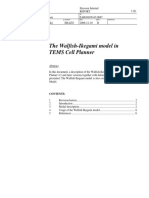Aim: Demonstration To Understand The Path Loss Prediction Formula
Aim: Demonstration To Understand The Path Loss Prediction Formula
Uploaded by
RajCopyright:
Available Formats
Aim: Demonstration To Understand The Path Loss Prediction Formula
Aim: Demonstration To Understand The Path Loss Prediction Formula
Uploaded by
RajOriginal Description:
Original Title
Copyright
Available Formats
Share this document
Did you find this document useful?
Is this content inappropriate?
Copyright:
Available Formats
Aim: Demonstration To Understand The Path Loss Prediction Formula
Aim: Demonstration To Understand The Path Loss Prediction Formula
Uploaded by
RajCopyright:
Available Formats
3171608 : Wireless Communication Practical-4
Practical – 4
Aim: Demonstration to understand the path loss prediction formula.
• Understand the pathloss prediction formula
The design of a communication system involves selection of values for several parameters. One
of the important parameter is the transmit power. Higher transmit power ensures large allowable
separation distance between the transmitter (Tx) and receiver (Rx). Of course the loss in signal
power per unit distance depends on the properties of the medium. In case of wireless communication
on one hand it is desired to have a very large coverage (large allowable separation between Tx and
Rx) on the other hand it is also desired that co-channel interference be as low as possible. An
understanding of the large scale propagation effects is very important for design of suitable
communication system. In terrestrial mobile communication system, electro-magnetic wave
propagation is affected by reflection, diffraction and scattering. These lead to dynamic variation of
signal strength as a function of time, frequency, distance of separation, antenna height, antenna
configuration, local scattering environment etc. Propagation models are necessary in order to predict
the received signal strength for a given set of parameters as mentioned above. These models can be
broadly considered under:-
1. Large scale Fading Model
2. Small Scale Fading Model
• Important Formulas
190173116017: Prajapati Vishal M. Page 1 of 9
3171608 : Wireless Communication Practical-4
• Advanced Formula
• 1A(Calculation of Received Power at a cer-tain Tx-Rx separation distance) :-
Step 1 :- Drag the mobile by placing the cursor on it and place it at a certain distance from the base
station tower.
Step 2 :-Click on the button TAKE READING.Your input value get displayed.
190173116017: Prajapati Vishal M. Page 2 of 9
3171608 : Wireless Communication Practical-4
Step 3 :-Now,calculate the value of the unknown parameter (for e.g.Pr(d)Pr(d)) manually by using
the formulas given in the theory section. For example:- Given Pr(d0)=18.44dBPr(d0)=18.44dB, Tx
and Rx separation distance(d)= 708 m, d0=55md0=55m. So,using this
formula Pr(d)=Pr(d0)+20log(d0/d)Pr(d)=Pr(d0)+20log(d0/d) you can find the value
of Pr(d),Pr(d)=−18.44+20log10(55/708)=−40.37dBm.Pr(d),Pr(d)=-18.44+20log10(55/708)=-
40.37dBm. Similarly,with the help of the formulas given in the theory section for
expt1b,expt1c,expt1d and expt1e you can find the value of the unknown parameter for each of these
experiments.
Step 4 :-Now,enter your manually calculated value of the unknown parameter in the box provided in
the page.
Step 5 :-Click on the button CHECK to verify whether your manually calculated value matches with
the computed value of the unknown parameter.
190173116017: Prajapati Vishal M. Page 3 of 9
3171608 : Wireless Communication Practical-4
Step 6 :-If your manually calculated value of the unknown parameter doesn't match with the com-
puted value of the unknown parameter then a message box will appear with the message that your
calculated value is wrong and it will return the exact value of the unknown parameter.If your cal-
culated value of the unknown parameter is same as the computed value of the unknown parameter
then the message box will let you know that your result is correct.
Step 7 :-Now, click on the button SUBMIT to submit your results
Step 8 :-You can redo the experiment by clicking on the button REDO.
190173116017: Prajapati Vishal M. Page 4 of 9
3171608 : Wireless Communication Practical-4
• 1B(Calculating the path loss exponent) :-
Step 1:-Follow Step 2 of Expt 1A and select Expt 1B to perform it.
Step 2:-Follow Step 3-4 of Expt 1A to record the input parameters needed for calculating the value
of npnp.You can adjust the slider to change the value of transmit power.
Step 3:- Now,use this formula to calculate npnp. Input Parameters
:- Pt=50dBm,Pr(d)=−54.45dBm,Pt=50dBm,Pr(d)=-
54.45dBm, Pr(d0)=−12.58dBm,d=1156meters,d0=89meters.PL(d)=PL(d0)+10∗np∗log10(d/d0)=Pt(d
)Pr(d0)=-
12.58dBm,d=1156meters,d0=89meters.PL(d)=PL(d0)+10∗np∗log10(d/d0)=Pt(d) −Pr(d)=Pt(d0)−Pr(
d0)+10∗np∗log10(d/d0),50+54.45=50+12.58+10∗np∗log10(1156/89),np=-Pr(d)=Pt(d0)-
Pr(d0)+10∗np∗log10(d/d0),50+54.45=50+12.58+10∗np∗log10(1156/89),np= 3.76 .
Step 4:- Follow Steps 6-11 of Expt 1A to submit the results of Expt 1B.
190173116017: Prajapati Vishal M. Page 5 of 9
3171608 : Wireless Communication Practical-4
• 1C(Calculating fc) :-
Step 1:-Follow Step 2 of Expt 1A and select Expt 1C to perform it.
Step 2:-Follow Step 3-4 of Expt 1A to record the input parameters needed for calculating the value
of fcfc.You can change the values of transmit power,transmit antenna height,receive antenna height
by adjusting the sliders.
Step 3:-
Given hBS=30m,hUT=1m,d=1092m,np=4.65,Pt=50dBm,Pr(d)=−83.22dBm,hBS=30m,hUT=1m,d=
1092m,np=4.65,Pt=50dBm,Pr(d)=-83.22dBm,. Now, calculate PL(d) using the formula:-PL(d)
= Pt−Pr(d)=Pt-Pr(d)=50 - (-83.22) = 133.22 dBm. Now, use this formula to calculate fcfc.PL(d)
= 10nplog10(d)+7.8−18log10(htx)−18log10(hrx)+20log10(fc)10nplog10(d)+7.8-18log10(htx)-
18log10(hrx)+20log10(fc). Putting the values, 133.22
= 10∗4.65∗log10(1092)+7.8−18log10(30)−18log10(1)+20log10(fc)10∗4.65∗log10(1092)+7.8-
18log10(30)-18log10(1)+20log10(fc). So,fcfc = 3.44 GHz.
Step 4:- Follow Steps 6-11 of Expt 1A to submit the results of Expt 1C.
190173116017: Prajapati Vishal M. Page 6 of 9
3171608 : Wireless Communication Practical-4
• 1D(Calculating hUThUT ):-
Step 1:-Follow Step 2 of Expt 1A and select Expt 1D to perform it.
Step 2:-Follow Step 3-4 of Expt 1A to record the input parameters needed for calculating the value
of hUThUT .You can change the values of transmit power,frequency,transmit antenna height by
adjusting the sliders.
Step 3:-
Given hBS=30m,fc=2GHz,d=1600m,np=4.02,Pt=50dBm,Pr(d)=−51.41dBm,hBS=30m,fc=2GHz,d=
1600m,np=4.02,Pt=50dBm,Pr(d)=-51.41dBm,. Now, calculate PL(d) using the formula:-PL(d)
= Pt−Pr(d)=Pt-Pr(d)=50 -(-51.41) = 101.41 dBm. Now, use this formula to calculate hrxhrx.PL(d)
= 10nplog10(d)+7.8−18log10(htx)−18log10(hrx)+20log10(fc)10nplog10(d)+7.8-18log10(htx)-
18log10(hrx)+20log10(fc). Putting the values, 101.41
= 10∗4.02∗log10(1600)+7.8−18log10(30)−18log10(hrx)+20log10(2)10∗4.02∗log10(1600)+7.8-
18log10(30)-18log10(hrx)+20log10(2). So,hrxhrx = 6.5 meters.
Step 4:- Follow Steps 6-11 of Expt 1A to submit the results of Expt 1D .
190173116017: Prajapati Vishal M. Page 7 of 9
3171608 : Wireless Communication Practical-4
• 1E(Calculating hBShBS) :-
Step 1:-Follow Step 2 of Expt 1A and select Expt 1E to perform it.
Step 2:-Follow Step 3-4 of Expt 1A to record the input parameters needed for calculating the value
of hBShBS. You can change the values of transmit power,receive antenna height,frequency by
adjusting the sliders.
Step 3:-
Given hrx=1m,fc=2GHz,d=668m,np=3.12,Pt=50dBm,Pr(d)=−29.01dBm,hrx=1m,fc=2GHz,d=668m,
np=3.12,Pt=50dBm,Pr(d)=-29.01dBm,. Now, calculate PL(d) using the formula:-PL(d)
= Pt−Pr(d)=Pt-Pr(d)=50 -(-29.01) = 79.01 dBm. Now, use this formula to calculate hBShBS.PL(d)
= 10nplog10(d)+7.8−18log10(htx)−18log10(1)+20log10(fc)10nplog10(d)+7.8-18log10(htx)-
18log10(1)+20log10(fc). Putting the values,
79.01= 10∗3.12∗log10(668)+7.8−18log10(htx)−18log10(hrx)+20log10(2)10∗3.12∗log10(668)+7.8-
18log10(htx)-18log10(hrx)+20log10(2). So,htxhtx = 16.55 meters.
190173116017: Prajapati Vishal M. Page 8 of 9
3171608 : Wireless Communication Practical-4
Follow Steps 6-11 of Expt 1A to submit the results of Expt 1E.
190173116017: Prajapati Vishal M. Page 9 of 9
You might also like
- 2G 3G Interview QuestionsDocument10 pages2G 3G Interview Questionsmohnish1999No ratings yet
- DSP 1Document4 pagesDSP 1Pavan KulkarniNo ratings yet
- 1131expt 03 MCC Be A SH21Document7 pages1131expt 03 MCC Be A SH21AlkaNo ratings yet
- National Institute of Technology: Communication Engineering Lab IIDocument11 pagesNational Institute of Technology: Communication Engineering Lab IIretgertreterNo ratings yet
- DSP Report DSPDocument49 pagesDSP Report DSProckettekcorNo ratings yet
- ECL 439 - Wireless CommunicationsDocument11 pagesECL 439 - Wireless CommunicationsjackNo ratings yet
- M Tech Project Phase 3Document33 pagesM Tech Project Phase 3jeevrkgNo ratings yet
- 411 2004 MidtermSolutionsDocument5 pages411 2004 MidtermSolutionsShaolin MonkNo ratings yet
- Hardware Design and Implementation of Digital Pulse Processor Using FPGADocument5 pagesHardware Design and Implementation of Digital Pulse Processor Using FPGAअमरेश झाNo ratings yet
- Design of Multichannel AP-DCD Algorithm Using Matlab: Sasmita DeoDocument5 pagesDesign of Multichannel AP-DCD Algorithm Using Matlab: Sasmita DeoParamesh WaranNo ratings yet
- Report MSC2Document10 pagesReport MSC2Afwan AriffinNo ratings yet
- Wireless Valley Software ValidationDocument14 pagesWireless Valley Software Validationمحمد الصنوميNo ratings yet
- Task No. 3: Generation of Signal Using DM Generation of Signal Using DPCMDocument12 pagesTask No. 3: Generation of Signal Using DM Generation of Signal Using DPCMAniket SaxenaNo ratings yet
- OFDM Simulation EE810Document18 pagesOFDM Simulation EE810Ashique Mahmood100% (1)
- Elec9123 DSP DesignDocument7 pagesElec9123 DSP DesignSydney FinestNo ratings yet
- DC - Experiment - No. 3CDocument8 pagesDC - Experiment - No. 3Camol maliNo ratings yet
- CONVOLUCIÓNDocument17 pagesCONVOLUCIÓNDavid NavarroNo ratings yet
- Power Spectrum Estimation-LabSheetDocument3 pagesPower Spectrum Estimation-LabSheetJai GaizinNo ratings yet
- Adesoji Lawal Radio Propagation Model Tunning2Document13 pagesAdesoji Lawal Radio Propagation Model Tunning2esojayNo ratings yet
- Wireless Communication LAb Manual - 02-11-21Document45 pagesWireless Communication LAb Manual - 02-11-21jayanth100% (2)
- Modulation and Multiplexing: How To Send Data Fast and Far?Document16 pagesModulation and Multiplexing: How To Send Data Fast and Far?Hacralo100% (1)
- A Highly-Efficient Multi-Band Multi-Mode Digital Quadrature Transmitter With 2D Pre-DistortionDocument4 pagesA Highly-Efficient Multi-Band Multi-Mode Digital Quadrature Transmitter With 2D Pre-DistortionSMBNo ratings yet
- Adc Lab ManualDocument78 pagesAdc Lab ManualELECTRONICS COMMUNICATION ENGINEERING BRANCHNo ratings yet
- N-Continuous Distortion For MIMO OFDM: Iterative Estimation and Cancellation of SystemsDocument4 pagesN-Continuous Distortion For MIMO OFDM: Iterative Estimation and Cancellation of SystemsMedhat MohNo ratings yet
- Operation Manual: Programmable Ultrasonic BoardDocument12 pagesOperation Manual: Programmable Ultrasonic BoardVictor SandovalNo ratings yet
- Tuning of The Propagation Model Itu-R P.1546 RecommendationDocument13 pagesTuning of The Propagation Model Itu-R P.1546 RecommendationSantosh KumarNo ratings yet
- Digital Communication Unit 8 VTUDocument36 pagesDigital Communication Unit 8 VTUraghudathesh0% (1)
- AmDocument8 pagesAmLisa TorresNo ratings yet
- ADSPT Lab5Document4 pagesADSPT Lab5Rupesh SushirNo ratings yet
- Ee-323 Digital Signal Processing Complex Engineering Problem (Cep)Document23 pagesEe-323 Digital Signal Processing Complex Engineering Problem (Cep)Rubina KhattakNo ratings yet
- Digital Communication Ece 304 Assignment-1Document9 pagesDigital Communication Ece 304 Assignment-1ramjee26No ratings yet
- Digital Communication Systems: ECE-4001 TASK-3Document12 pagesDigital Communication Systems: ECE-4001 TASK-3Aniket SaxenaNo ratings yet
- Spread Spectrum - LabDocument4 pagesSpread Spectrum - LabBibhakar Saha100% (1)
- 1 Bit Sigma Delta ADC DesignDocument10 pages1 Bit Sigma Delta ADC DesignNishant SinghNo ratings yet
- M 3.1. Analog Measurements of NoiseDocument56 pagesM 3.1. Analog Measurements of NoisejcsabaNo ratings yet
- Filter Programs MatlabDocument8 pagesFilter Programs MatlabPreethi Sj100% (1)
- Lab 2Document4 pagesLab 2Risinu WijesingheNo ratings yet
- ECEN325 Lab ManualDocument66 pagesECEN325 Lab ManualIrwan RamliNo ratings yet
- Lab 3-CDocument6 pagesLab 3-CMUHAMMAD AMMARNo ratings yet
- Solved Problems: EE160: Analog and Digital CommunicationsDocument145 pagesSolved Problems: EE160: Analog and Digital CommunicationsJoseSimoes100% (1)
- A FPGA Based TDEMI Measurement System For Quasi-Peak Detection and Disturbance AnalysisDocument4 pagesA FPGA Based TDEMI Measurement System For Quasi-Peak Detection and Disturbance AnalysisAli ShaebaniNo ratings yet
- DSP Lab MaualDocument53 pagesDSP Lab MaualAllanki Sanyasi RaoNo ratings yet
- Exp 8Document7 pagesExp 8growthman.100No ratings yet
- Lab 4Document30 pagesLab 4awab ahsanNo ratings yet
- Introduction To Spread SpectrumDocument108 pagesIntroduction To Spread SpectrumBharath Prabhu PNo ratings yet
- Mob Net 2012 Exam SolutionDocument16 pagesMob Net 2012 Exam SolutionMohammad IrsheadNo ratings yet
- AC Lab MAT & Multi - Sim ProgramsDocument13 pagesAC Lab MAT & Multi - Sim ProgramsAlekhya ArasavalliNo ratings yet
- Chương 4Document9 pagesChương 4quochaiho2404No ratings yet
- Lab BookDocument70 pagesLab Bookअमरेश झाNo ratings yet
- Laboratory Manual: ECE 407 Unified Electronics Lab-VDocument33 pagesLaboratory Manual: ECE 407 Unified Electronics Lab-VShubra MahajanNo ratings yet
- CN PRACTICAL PaperDocument30 pagesCN PRACTICAL PaperatikpNo ratings yet
- MATLAB Based PCM Modeling and Simulation: TELKOMNIKA, Vol. 11, No. 10, October 2013, Pp. 5973 5979Document7 pagesMATLAB Based PCM Modeling and Simulation: TELKOMNIKA, Vol. 11, No. 10, October 2013, Pp. 5973 5979Thu ThuyNo ratings yet
- MdsDocument5 pagesMdsanalogakNo ratings yet
- Digital Communication Systems: ECE-4001 TASK-3Document11 pagesDigital Communication Systems: ECE-4001 TASK-3Aniket SaxenaNo ratings yet
- Measurements and Modelling of Nonlinear Power AmplifiersDocument4 pagesMeasurements and Modelling of Nonlinear Power Amplifiersnayeem4444No ratings yet
- Revision PartB May 2019 IIDocument12 pagesRevision PartB May 2019 IIfahimmalik123456789No ratings yet
- CS Lab Manual OriginalDocument30 pagesCS Lab Manual OriginalK Vinod KumarNo ratings yet
- Arduino Measurements in Science: Advanced Techniques and Data ProjectsFrom EverandArduino Measurements in Science: Advanced Techniques and Data ProjectsNo ratings yet
- Dokumen - Tips - Link Budget Lte UplinkDocument3 pagesDokumen - Tips - Link Budget Lte UplinkMohamed EmadNo ratings yet
- WIM2 Matlab Documentation V1.0Document24 pagesWIM2 Matlab Documentation V1.0Белла МихайловаNo ratings yet
- Diagrama de Instalación de Equipo Banda Ancha Punto A Punto Mazo Cruz - KenkoDocument4 pagesDiagrama de Instalación de Equipo Banda Ancha Punto A Punto Mazo Cruz - KenkoRodrigo Marcelo Parra AguilarNo ratings yet
- Atoll GSM Training SlidesDocument128 pagesAtoll GSM Training SlidesClaudio Ramón López MezaNo ratings yet
- TCP Walfish-Ikegami Model Strippad ADocument6 pagesTCP Walfish-Ikegami Model Strippad AWaqas AhmedNo ratings yet
- WC Ec8652 QB-1Document24 pagesWC Ec8652 QB-1ManimegalaiNo ratings yet
- Link Budget CalculatorDocument13 pagesLink Budget CalculatorYounesNo ratings yet
- Chapter 3 Large Sclae Class - 2 1Document88 pagesChapter 3 Large Sclae Class - 2 1Selam TadeleNo ratings yet
- Reporte Cluster A3754 - LL - PUENTE VIRUDocument31 pagesReporte Cluster A3754 - LL - PUENTE VIRUgriosfNo ratings yet
- Lab ManualDocument48 pagesLab ManualA'ziz MoNo ratings yet
- Mobile Radio PropogationDocument59 pagesMobile Radio PropogationKaruna Lakhani100% (1)
- Dcs Unitwise Important QuestionsDocument5 pagesDcs Unitwise Important QuestionsSunil KumarNo ratings yet
- Interference WCDMA and PCS 1900Document4 pagesInterference WCDMA and PCS 1900ali963852No ratings yet
- Radio Propagation Models Comparison and Tuning For LTE Based On Experimental Data in Tripoli-LibyaDocument4 pagesRadio Propagation Models Comparison and Tuning For LTE Based On Experimental Data in Tripoli-LibyaTaha AlmoktarNo ratings yet
- Indoor Multi-Wall Path Loss Model at 1.93 GHZDocument6 pagesIndoor Multi-Wall Path Loss Model at 1.93 GHZadonniniNo ratings yet
- Huawei LTE RNP Introduction1Document31 pagesHuawei LTE RNP Introduction1Hân Trương100% (1)
- Telecommunications Engineering Lab: Section: A Lab No: 5 GR No: Semester: Fall 21-22 DateDocument11 pagesTelecommunications Engineering Lab: Section: A Lab No: 5 GR No: Semester: Fall 21-22 DateShazzadNo ratings yet
- Module 1 Notes (17EC81)Document16 pagesModule 1 Notes (17EC81)gagan mrNo ratings yet
- WC 4 - Shivani - Varu - 190423116010Document4 pagesWC 4 - Shivani - Varu - 190423116010Shivani VaruNo ratings yet
- Huawei ACPDocument18 pagesHuawei ACPmlmb tuhNo ratings yet
- CQ Datv71Document29 pagesCQ Datv71Black OnionNo ratings yet
- Example Link BudgetDocument16 pagesExample Link Budgetabhaykumar80100% (1)
- UBWA Training GuideDocument70 pagesUBWA Training GuideJefersonNo ratings yet
- Space Wave PropagationDocument16 pagesSpace Wave PropagationVarnika SinghNo ratings yet
- MultiBand Antenna - Initial Approved Design Zain - 2.2Document4 pagesMultiBand Antenna - Initial Approved Design Zain - 2.2Muhammad ShahidNo ratings yet
- Survey System Design and EngDocument123 pagesSurvey System Design and EngAndrada AdaNo ratings yet
- IBwave Release NotesDocument42 pagesIBwave Release NotesMayar ZoNo ratings yet
- Okumura Vs Cost HattaDocument5 pagesOkumura Vs Cost HattaGregory LevantNo ratings yet
- Sample Solution To Problem Set 1Document5 pagesSample Solution To Problem Set 1Cindy AyenNo ratings yet

























































































